- Home
- |
- About Us
- |
- Working Groups
- |
- News
- |
- Rankings
- WEF-Global Competitiveness Report
- Ease of Doing Business Report
- IMD-World Competitiveness Yearbook
- TI-Corruption Perceptions Index
- HF-Economic Freedom Index
- WEF-Global Information Technology Report
- WEF-Travel and Tourism Report
- WIPO-Global Innovation Index
- WB-Logistics Performance Index
- FFP-Fragile States Index
- WEF-Global Enabling Trade Report
- WEF-Global Gender Gap Report
- Gallery
- |
- Downloads
- |
- Contact Us
Dialogue on Bottom-Up Budgeting : Private Sector Participation in the Budget Process (Post Activity Report)
Highlights:
The NCC has recently launched the “NCC Dialogues Series”, designed to bring together key policy makers, business and NGO leaders to discuss, take action and participate in government programs.
The NCC conducted its first Dialogue last August 30, 2012, which featured Private Sector Participation in the Budget Process with Budget Secretary Florencio “Butch” Abad. This was held at Hotel Intercontinental in Ayala, Makati City attended by more than 200 participants composed of foreign/local chambers, business-private and public sectors, diplomats, NGOs and media people.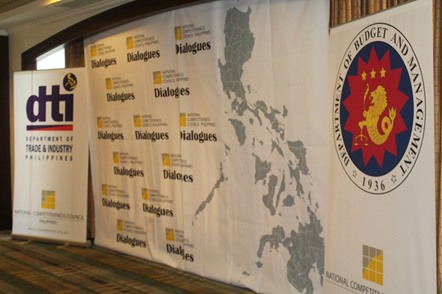
This is in line with the thrust towards greater fiscal transparency and accountability and more meaningful private sector and citizen engagement in the budget process and the reforms being undertaken by the government with respect to budget preparation, disbursement, cash management and monitoring. The new online diagnostic tool known as BudgetngBayan.com was also launched and participants were able to view a live demonstration of this site. It further illustrated how constituents and tax payers can review the status of the 2012 Budget and analyze the 2013 Budget.
Among other things, it was also presented that the government has now completed its first-ever total inventory of personnel across all departments so that it can shortly start processing payroll directly to each individual employee account and deduct withholding tax payments and GSIS premiums for direct remittance to the BIR and GSIS, something it had never been able to do. It is also running a cashless purchase card system on a pilot basis covering regularly-procured items so that liquidations and accounting of funds can be handled more efficiently and effectively.
As promised in Dialogues, the NCC wants to give people the opportunity to be Informed, get Engaged, and Act and encourage the public to try out the DBM and BudgetngBayan.com websites.
Dialogue Proper
Opening Remarks, Guillermo M. Luz, NCC Private Sector Co-Chairperson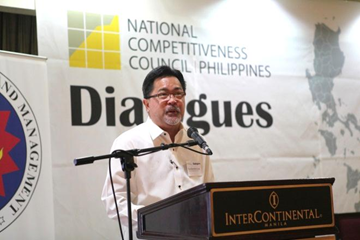
Mr. Guillermo M. Luz explained the rationale behind the conduct of the newly launched Dialogues. These meetings cover issues under discussion by our Working Groups which the NCC feel the need to be discussed by a broader public. The basic objective of Dialogues is to go beyond merely informing people about issues. Dialogues should inform, engage, and equip people with a means of acting on the information they receive.
In the light of the recent submission of the proposed 2013 National Budget to Congress, Mr. Bill Luz emphasized the importance of this Dialogue that will illustrate how constituents and tax payers can review the status of the 2012 Budget and analyze the 2013 Budget and more importantly, new online diagnostic tools known as BudgetngBayan.com shall have to be launched and known by the general public.
Ms. Tammy Lipana, NCC Private sector Champion introduced Secretary Butch Abad as the main speaker. Ms. Marilou Cristobal acted as the master of ceremonies of the event.
Full Documentation of Secretary Butch Abad’s Presentation :
- Budget 101
- Status of the 2012 Budget and Key Features of the 2013 Budget
- Public Financial and Expenditure Management Reform Initiatives
- Bottom-Up Budgeting
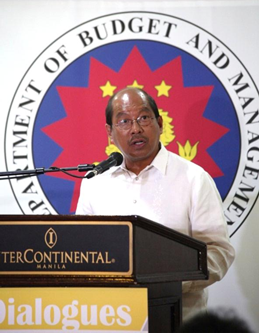 Sec. Abad pointed out that equally important to installing reformists in government is setting up systems that enable good governance. Inspired by Sec. Robredo’s good governance practice they vowed that in DBM, they have deepened their commitment to pursue systemic reforms in public finance. However, even as spending has dramatically increased year-on-year, the need to speed-up the reforms to ensure that public institutions spend within our means, on the right priorities and with measurable impact have to be assured. The proposed National Budget for 2013, designed to deepen reform and to accelerate the achievement of our priority development targets are embedded in the 2013 NEP are consistent with our Public Financial Management (PFM) reform roadmap 2011-2015. While the PFM reform roadmap introduces unprecedented and major changes to our PFM systems (such as GIFMIS and TSA), the need to pursue the political dimension of reform and address the systemic problem of patronage is imperative.
Sec. Abad pointed out that equally important to installing reformists in government is setting up systems that enable good governance. Inspired by Sec. Robredo’s good governance practice they vowed that in DBM, they have deepened their commitment to pursue systemic reforms in public finance. However, even as spending has dramatically increased year-on-year, the need to speed-up the reforms to ensure that public institutions spend within our means, on the right priorities and with measurable impact have to be assured. The proposed National Budget for 2013, designed to deepen reform and to accelerate the achievement of our priority development targets are embedded in the 2013 NEP are consistent with our Public Financial Management (PFM) reform roadmap 2011-2015. While the PFM reform roadmap introduces unprecedented and major changes to our PFM systems (such as GIFMIS and TSA), the need to pursue the political dimension of reform and address the systemic problem of patronage is imperative.
On National Government Expenditure Performance
From January to July this year, the national government has spent 15.1 percent more than in the same period of last year. This is better than the 13.8-percent growth year-on-year that was registered during the first half of the year. If we look at the monthly trend, from January to July, you can see that the performance has been improving versus last year. The growth of disbursements in the month of July alone reached a whopping 21.8 percent, the highest growth rate so far this year.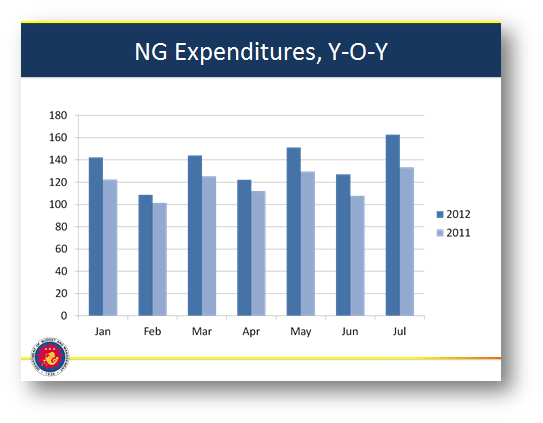
It was underscored the need to constantly improve systems and address bottlenecks in budget execution. Take the case of the DPWH, which has generated billions in savings last year after it painstaking reformed its project cost assumptions and procurement processes. Because of these, even if DPWH spent lower last year compared to the previous years, thus, we know that each peso is now spent on the right project, at the right cost and the right quality. In other words we need quality spending and quality institutions—that which leads to maximum impact and optimal value—to achieve inclusive growth.
We have to realize that, beyond the aggregate amount of money that government spends, the more fundamental issue that we must face is the capacity of public institutions to spend and to deliver services with impact, and to address the systemic bottlenecks and inefficiencies, so that we may meet our spending targets and development goals.
C. The 2013 Empowerment Budget: Designed to Deepen Reform
Regarding the effort to hike public spending in the immediate, it must be kept in mind the need to systematically and decisively meet these fundamental objectives, which have been integrated in the design of the proposed P2.006-trillion National Budget for 2013.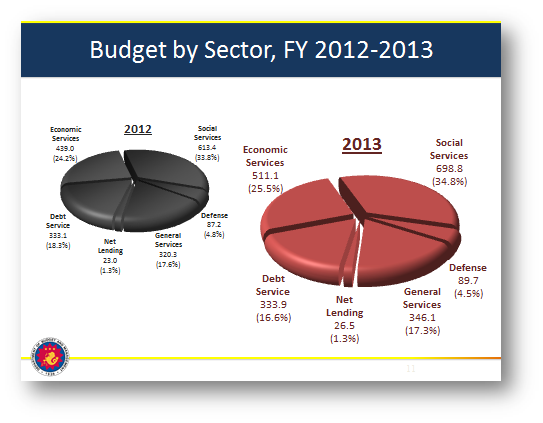
This is called Empowerment Budget for it “pursues empowerment by creating more opportunities for public participation in governance. It creates the foundation and fiscal space that will ultimately allow the private sector to take its rightful role as the engine of inclusive and sustained growth. By private sector, it does not only refer to the business sector, but also community-based economic initiatives like microfinance, cooperatives and community-driven enterprises.
The core principles and strategies that shaped the 2013 Empowerment Budget: Greater and deeper commitment to the Aquino Social Contract; Accelerated completion of priority program targets; Stronger government accountability to perform; Transparency for faster budget execution and clearer results; And last but not the least, greater stakeholder participation in budget preparation and execution.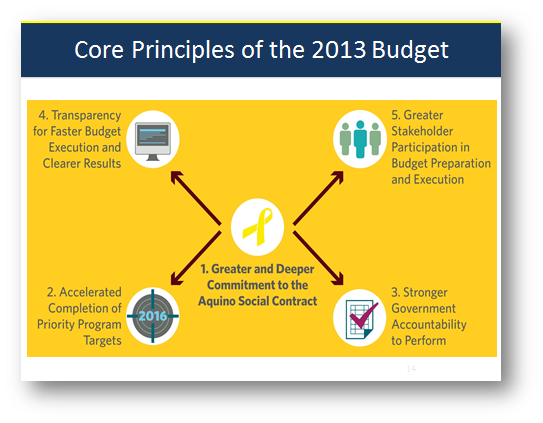
To ensure the utmost prioritization of funds for these KRAs, key budgeting approaches such as Zero-Based Budgeting and Program Budgeting are being undertaken. Priority programs have been defined per KRA; and that these should be coordinated to ensure the delivery of results.
To speed up budget execution, a mechanism for closer performance monitoring has already been set-up. DBM set-up Account Management Teams that will ensure timely execution of programs and projects and to address implementation bottlenecks, in nine pilot departments: DPWH, DOTC, DepEd, DoH, DSWD, DA, DAR, DND and DILG. Through this Budget, we hope to strengthen the accountability of public institutions and public servants to their performance mandates.
One such innovation DBM shall be introducing next year is a Performance-Based Incentive System, which rewards a performance bonus for teams in the bureaucracy who meet or even surpass their outcomes and commitments in line with Aquino Social Contract. With this in place, we hope to institute a system of performance contracts next year, to which every Cabinet member will be required to sign with the President.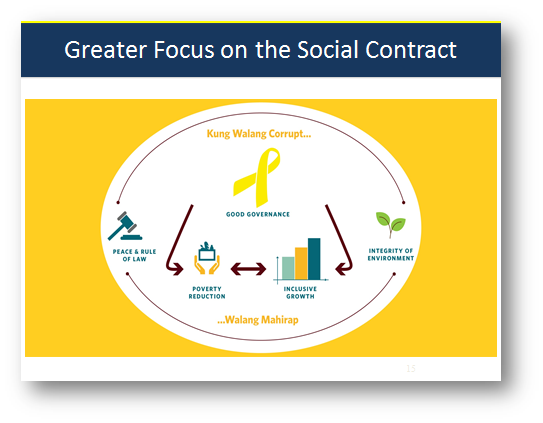
In preparing the proposed budget, the Aquino Administration piloted the Bottom-Up Budgeting Approach, where 609 poor municipalities were tasked to identify their needed services in a consultative process with civil society (CSO) and community organizations. The process of agency-CSO partnerships in budget preparation was also expanded to cover 12 departments and six GOCCs.
Public-Private Partnerships will again be used as a strategy to speed-up the delivery of key social services and facilities. The construction of school houses, rural health facilities and hospitals will be packaged for Build-Transfer arrangements with the private sector.
The PFM Reform Roadmap and the Problem of Patronage
All of these embedded reforms in our annual National Budget are consistent with a Public Financial Management (PFM) Reform Roadmap. This reform roadmap seeks to improve the efficiency, accountability and fund use to ensure direct, immediate and substantial delivery of public services.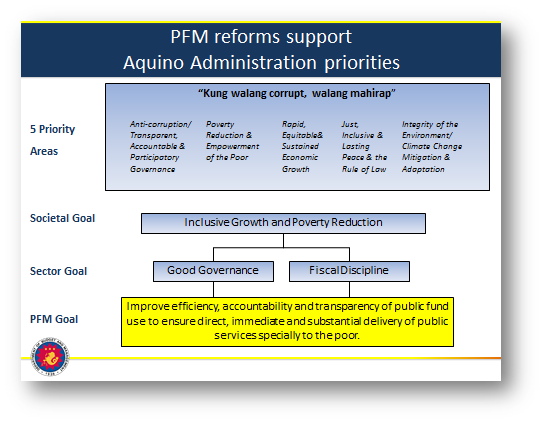
Its component-outputs include the establishment of a Results-Based Budgeting System, which will enable us to monitor and report—in a more accurate and timely manner—the efficiency and effectiveness of public spending and the results that each peso must produce.
Another component is the installation of a Treasury Single Account by 2014. This will be a major change in our cash management operations, because it means that government will have a single account managed by the national treasury. This will provide more reliability and predictability in budget releases, cash programming and financial reporting.
To be installed is a Government Integrated Financial Management Information System, which will be a system that will provide real-time information on financial transactions. This GIFMIS will not only harmonize the information systems of DBM, DoF-BTr and COA but will also be rolled-out eventually to the implementing departments. A key component of this GIFMIS is the National Payroll System. Another important aspect of installing this GIFMIS is the harmonization of our chart of accounts with the Commission on Audit and the Bureau of the Treasury.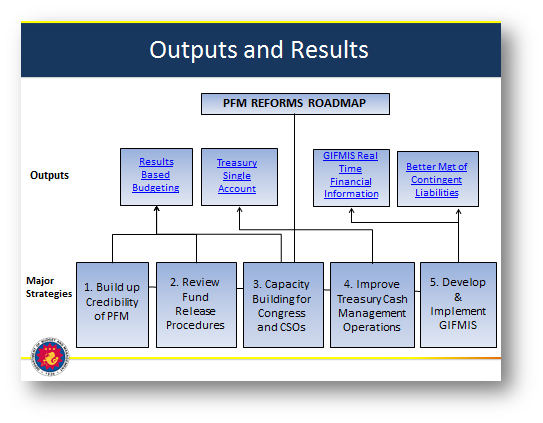
Lastly, Installing a System for Better Contingent Liability Management, which we hope will minimize government’s financial exposure due to the liabilities incurred by GOCCs or in the process of BOTs and PPPs.
Role of the Private Sector in Budget Reform
Reform work isn’t just technical or administrative or even legal, and that we need to pay attention to an equally-important dimension of reform: the political one but the private sector plays a key role in our pursuit of transformation in our society. But the role of increasing productivity and improving employment and incomes really rests in the hands of the private sector.
Of course, we in government need to do our part: to ensure that our youth are better educated and are healthier; that the necessary infrastructure to help move people and commodities are in place; that public safety from human and even environmental threats is secured. That is what we intend to do, using the reformed National Budgets under the Aquino Administration.
Emphasized is that the private sector is a potent co-advocate of reform, of good governance and inclusive development. After all, their main motivation is to ensure fairness in the market and to establish a level and competitive playing field.
DBM believes that the identification of macroeconomic and fiscal risks—key factors that influence budget preparation and execution—should be opened to the private sector’s participation. While economic forecasting is a core function and even sole authority of the government, we concede that private sector economists, industry strategists and the like see market and other economic developments that government cannot see clearly. It would be good if we can combine our vantage points.
Download the Presentation and Talk Points
Presentation of Undersecretary Richard Moya, Demonstration of Etails and budgetingbayan.com
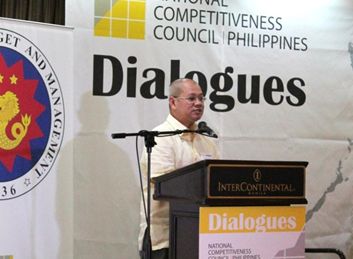 Significantly, the Department of Budget and Management has placed online all lump-sum budget allocations for Congressmen and Senators on a real-time basis so constituents can now find out what projects are being funded locally with their Senators' and Congressmen's approval under their PDAF allocations. This project is known as eTAILS and can be accessed on the DBM website (http://www.dbm.gov.ph) and clicking on the eTAILS button. The database is searchable by name or province.
Significantly, the Department of Budget and Management has placed online all lump-sum budget allocations for Congressmen and Senators on a real-time basis so constituents can now find out what projects are being funded locally with their Senators' and Congressmen's approval under their PDAF allocations. This project is known as eTAILS and can be accessed on the DBM website (http://www.dbm.gov.ph) and clicking on the eTAILS button. The database is searchable by name or province.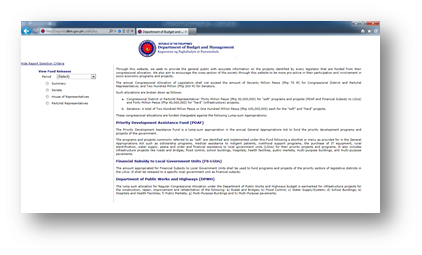
Undersecretary Richard Moya demonstrated DBM’s new BudgetngBayan.com website which contains the details of the 2012 and 2013 (proposed) national budgets. This site breaks down the national budget by sector, Cabinet department, region, and expenditure line item. It provides citizens and other interested parties with the ability to analyze the budget and to actually play out scenarios for shifting expenses from 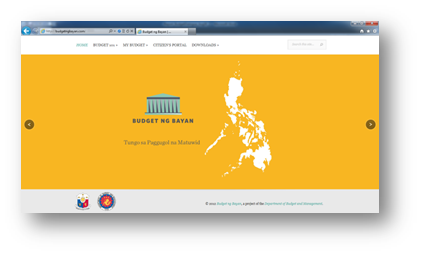 one sector to another. The site is an indispensable tool for those who want to monitor to see that the national budget is spent properly. It is transparency in action.
one sector to another. The site is an indispensable tool for those who want to monitor to see that the national budget is spent properly. It is transparency in action.
Open Forum
(Q) Drexx Laggui commented that small enterprises, as the real innovators are not welcomed in procurement policies in the government and asked if there is any reform or change to this system.
(A) Usec Moya said that laws are laws and that procurement group follows these procurement laws. But the good news is that there is an on-going discussion between the ICT office and the technical working group of the Procurement service to find an innovative way to procure IT. Because when they crafted the procurement law, many of the IT infrastructures, software and service focusing on licencing for government are not yet available. Also, he added, that they have to recognize that when they procure, they have to procure in a procurement accredited group, and the procurement group is subject to the procurement rules including the procurement service organizations.
(Q) Peter Wallace asked regarding the ICT as a department specifically pertaining to computerization in Government, stating the need to oversee government processes. How will you convince the president on the need to create an ICT Department?
(A) Secretary Abad said that he thinks there is an on-going debate regarding this legislation that would recognize digitizing government operations; the President would normally ask recommendations if such is an appropriate mechanism to ensure that we are going to achieve our objectives.
(Suggestion) Mr. Estanislao advocated the operationalization of the PPP on budget deliberations. He suggested that every department and every regional office should have multi-sectoral governance coalitions which should be welcomed as an on-going process and not just as a one-time activity.
(Q) Forbes asked how large the Philippines would want to make it by the end of the President Aquino’s Administration and how will the country raise the revenues to do so.
(A) Sec. Abad said that funds will be sourced from the sin tax, adjustments on minimal and fiscal incentives. He emphasized that absorption is the keyword.
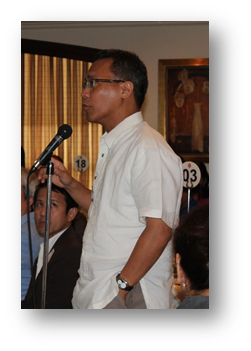 (Q) Juan Miguel Luz asked How to cement reforms so that information like this continues to go on. Mr. Luz further expounded that there were lots of good reforms in the past but succeeding administrations ended up not following the reform. Since this administration is very open in giving out or providing this information. However, what is the guarantee that the next administration will keep the reform? Will this Freedom of Information Act help cement the reform so that it continues beyond the Aquino Administration?
(Q) Juan Miguel Luz asked How to cement reforms so that information like this continues to go on. Mr. Luz further expounded that there were lots of good reforms in the past but succeeding administrations ended up not following the reform. Since this administration is very open in giving out or providing this information. However, what is the guarantee that the next administration will keep the reform? Will this Freedom of Information Act help cement the reform so that it continues beyond the Aquino Administration?
(A) Sec. Abad believed that the FOI bill will help ensure that these reforms will be irreversible. He also added that private collaboration is needed. He admitted that risk is always great because of politics. However this will be counteracted with continuing cooperation with the private sector communities. The more the government opens up and the more that functions are shared to more people as possible has big likelihood that reforms will stay.
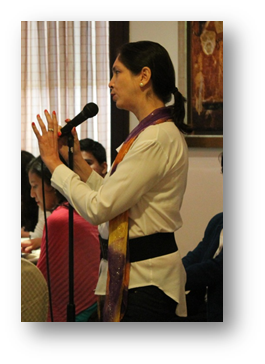 (Q) Ms. Bettina Quimson noticed that a big chunk of funds goes to the social services. In order to eradicate poverty, the best way is thru education. Given the situation, same with the private schools with similar curriculum the bone of contention would be the difference in the teachers and teaching quality. That is the problem in the entire country. Have you considered using ICT to standardize education and raise education to international standards?
(Q) Ms. Bettina Quimson noticed that a big chunk of funds goes to the social services. In order to eradicate poverty, the best way is thru education. Given the situation, same with the private schools with similar curriculum the bone of contention would be the difference in the teachers and teaching quality. That is the problem in the entire country. Have you considered using ICT to standardize education and raise education to international standards?
(A) Secretary Abad agreed with ICT as an important factor in increasing teaching standards. He further said that he would like that the teachers become adept with technology. He concluded by saying that the department is interested in improving the education system in the country.
(Suggestion/Comments) Ms Quimson mentioned that it’s a mind-set wherein teachers want to do what’s best for the students but the problem is that they don’t know ICT especially in the province. The paradigm shift or the culture of change will have to be that teachers will actually become facilitators and that the actual curriculum will be digitized by which the teachers will no longer be teaching computers but will just be moderating what is on the system.
(Q) AusAID – not too many CSOs in DILG and other agencies tap CSO partnership (Academe, NGOs,) what we can do about it?
(A) Secretary Abad answered that every time they meet with the directors of DBM’s line Agencies to speak about budgeting, they also meet with the sectors as well as government agencies to speak about the importance of bottom-up budgeting. He further added that they are really open to inquiries especially in fora like this.

